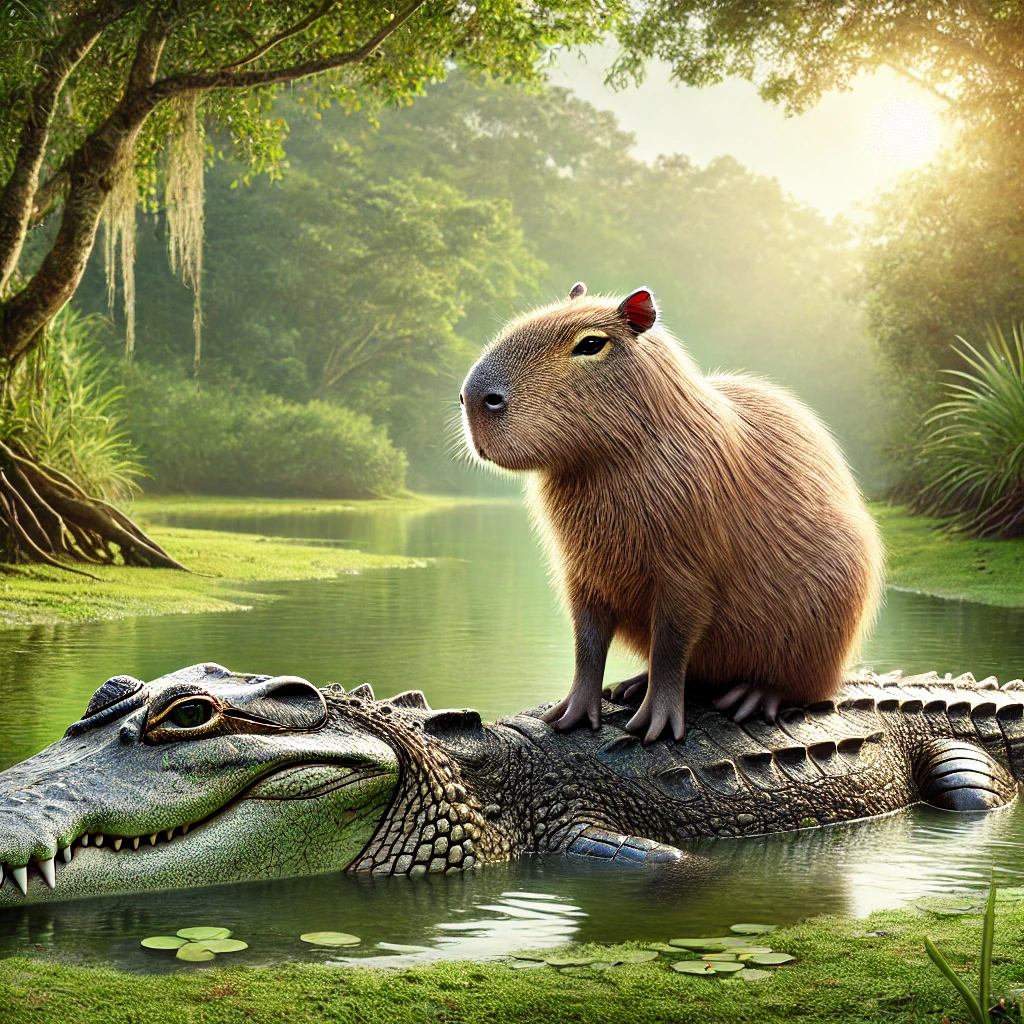An image of a capybara riding a crocodile on social media has captured the attention of animal enthusiasts and scientists alike, generating interest and curiosity. In this article, we will explore the theories surrounding this remarkable behavior and examine the biological and ecological factors involved.
1. The Social Nature of Capybaras
In large groups, capybaras often number up to 100 individuals, and they are known for their gentle and peaceful nature, both towards their own kind and toward other animals. The capybara engages in a variety of social behaviors, including grooming, interacting with other species, and coexisting peacefully with birds and reptiles without displaying signs of aggression. It may be because of this social tendency that they seem comfortable sharing their space with crocodiles, despite the danger they may pose.
A Shared Habitat
There are many similarities between capybaras and crocodiles in their native habitats, especially in South American wetlands, rivers, and lakes, where both species find food and shelter in abundance. As herbivores, capybaras do not compete directly with crocodiles, making it easier for them to perform seemingly unusual behaviors, such as riding on their backs.
2. Mutual Benefits
Cleaning and Grooming Symbiosis
It is widely believed that the capybara’s interaction with crocodiles is the result of mutualistic behavior. Capybaras groom other animals to remove parasites and dirt. In a similar vein, it is possible that the capybara rides on the back of a crocodile to help clean its skin. Crocodiles, A capybara’s presence could assist in removing parasites, offering the reptile a cleaning service.
This symbiotic relationship might not be entirely conscious, but rather a natural interaction that benefits both species. This theory highlights the possibility that capybaras may inadvertently aid crocodiles maintain skin hygiene through their grooming behavior.
Safety and Resting Spots
According to another theory, capybaras use crocodiles as safe resting areas or to escape potential predators. Crocodiles, as apex predators, aren’t typically threatened by other animals, making their backs an ideal perch. Crocodiles provide a safe platform for capybaras since they are often preyed upon by jaguars, caimans, and large birds of prey.
In addition, the crocodile’s size and territorial nature might discourage other animals from approaching, providing a temporary safe haven for the capybara. In this context, the interaction may appear opportunistic rather than deliberate or mutual.
3. The Role of Instinct and Observation
Capybara Intelligence and Adaptability
It is known that capybaras can mimic the behavior of other species to survive in their natural habitat. They are highly intelligent and adaptable animals that can quickly learn how to navigate their environment. Capybaras may have discovered that crocodiles, being powerful and dominant animals, offer them protection from smaller predators. This behavior may result from their natural instinct to seek shelter in groups or in the company of stronger animals.

There are some capybaras that interact with crocodiles, although they may have learned this behavior by experiencing the reptiles repeatedly in their habitat. It could explain how some capybaras approach crocodiles confidently and even ride on them.
Capybara Playfulness and Curiosity
The playful and curious nature of capybaras may also play a part in their interactions with crocodiles. Capybaras enjoy exploring their surroundings and interacting with animals of all kinds, often approaching them with a calm and non-threatening demeanor. As a result of their natural curiosity, they may interact with crocodiles if they observe that they do not pose a threat.
The playful behavior of capybaras may be mistaken for a purposeful ride when they are simply exploring the back of a crocodile.
4. Crocodile Behavior
The Role of Crocodile Territoriality
During mating season, and when defending their nests, crocodiles are territorial animals. However, they are not necessarily aggressive towards all species. Although crocodiles are capable of attacking and preying upon smaller animals, such as capybaras, they may not always perceive them as a threat. A crocodile may not pursue a capybara unless it is hungry or feels threatened, since crocodiles are opportunistic feeders.
In some instances, a capybara may be accepted as a part of the community by a crocodile, particularly if it does not directly challenge it. It may be because of this lack of immediate threat that capybaras seem unconcerned when riding or resting on crocodiles.
A Mutual Understanding Between Species
Occasionally, capybaras and crocodiles may form a mutual understanding. Crocodiles are not territorial towards all species of animals, so capybaras may perceive crocodiles as passive or neutral. The ability to interact with crocodiles in a non-aggressive manner may create an environment where capybaras feel comfortable.
5. Ecological and Evolutionary Implications
The Balance of Nature
Ecological balance is reflected in the relationship between capybaras and crocodiles. A healthy and stable ecosystem depends on interactions between species-whether cooperative, neutral, or competitive-in ecosystems with multiple species sharing the same habitat. It is their shared ecosystem that is delicately balanced by capybaras and crocodiles, despite their stark differences in size and behavior.
Evolutionary Considerations
In evolutionary terms, behaviors such as capybaras riding crocodiles may stem from instinctual adaptations to survive in a shared habitat. It is possible that capybaras use their intelligence, curiosity, and social nature to form non-threatening interactions alongside crocodiles, which remain formidable predators. These behaviors may be the result of evolutionary pressures that have led both species to live in harmony with each other over time.
FAQs
Why do capybaras ride on crocodiles?
Are capybaras in danger when interacting with crocodiles?
Is this behavior common among capybaras?
How do capybaras and crocodiles coexist in the wild?
Could capybaras and crocodiles have a symbiotic relationship?
Conclusion
It highlights the complexity of animal behavior and the delicate balance of ecosystems when capybaras and crocodiles interact. The bond between these two species illustrates the adaptability and social nature of capybaras, whether for parasite removal, safety, or simple curiosity. While further research is needed to fully understand the motivations behind these interactions, it is clear that both capybaras and crocodiles have developed unique ways of coexisting in their shared environments.
